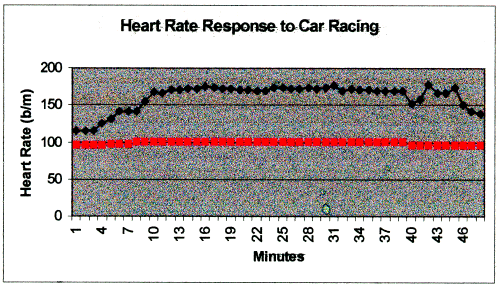The following study was conducted on Sunday on August 8, 2004 at the SIR Raceway in Auburn, Washington. The purpose was to see if rates of dehydration in race car drivers could be predicted with a portable device that can be worn as a wrist watch. The watch, produced by Acumen Inc., had three specially built in components to compute the hydration levels of the drivers; a humidity sensor, temperature sensor, and a heart rate monitor. An algorithm was employed that required the following 5 subject variables be input into the watch: age, weight, resting heart rate, maximum heart rate, and aerobic fitness level in MET’s. Descriptive statistics of the driver are displayed in the table below:
Age:                     35 Sex:                      male Weight:         188 lbs Fitness level:     10.2 MET’s Resting HR:     72 b/m Maximum HR:  190 b/m Temperature:     High 70’s, Low 80’s Humidity:           Low 50’s Class:           EP class Finish:          1st place, (seated 9th) Ave. Lap Time: 1:45.5 Fastest Lap:    1:44.4Pre-Race Warning/Positioning Lap
Data measurements were began at the 5 minutes pre race warning. This was to gather information on pre-race jitters, and the magnitude of the pre-anticipatory stimulus from the cerebral cortex. Heart rate was approximately 110-120 beats per minute for the first 3 minutes of pre race warning. At minute 3 the drivers started their engines, and an increase in heart rate of 10 beats per minutes were noted from minute 3 to minute 4.
At 3:55 seconds the car and driver were released to the track, and the drivers heart rate reached 130-135 minutes, increasing during the pre positioning lap to the low 140’s until the green flag was given at minute 8:08.
Green Flag
Over the first 30 seconds of the race the heart rate increased from 143 to 166 beats per minute leveling off during the first lap.  Throughout the race heart rates remained in the low 170’s reaching a low of 164 b/m early in lap 2. At the latter stages of the race, (lap 12) the heart rate increased from 169 to 185 b/m, a 16 beat difference for over 20 seconds. This was the largest variation and highest obtained heart rate during the race, 185 beats per minute. Heart rates for most of the race remained in a relatively narrow range of 166 to 173 beats per minute.
Post Race
Nearly 45 seconds after crossing the finish line, the heart rates dropped quickly into the low 150’s.  Over the next several minutes the heart rate decreased to 134 beats per minute before the watch was turned off.
Fluid Loss Race Competition:
Fluid loss during the race competition was predicted very accurately using the Acumen Hydra-Alert watch system. Actual losses were estimated at 46.4 ounces in the 30 minute qualifying race. Predicted losses were estimated at 46.1 ounces on the watch. Fluid loss was not measured in the sweat contained in the underwear of the driver, estimated at approximately one ounce, and another 5-6 ounces were lost in the approximate 15 to 20 minutes that the driver took to get dressed, and sit with his vehicle in the staging area.   Temperature in the afternoon race was approximately 90 degrees on the track with 50% humidity.
Summary:
-1.0 Â Â Â Â Â Â Â Â Â Â Â ounces lost in sweat contained in underwear of driver
– 5.5 Â Â Â Â Â Â ounces in time to get dressed and get to staging area.
-46.4Â Â Â Â Â Â -ounces lost on scale.
46.1 Â Â Â Â Â Â ounces recorded in fluid loss on the Hydro-Alert system.
Most expert recommendation state that fluid replacement should exceed the weight lost on the scale by as much as 25%. A near optimal rate of fluid replacement of 116% of what was lost on the scale was reported.
Impressions:
Typically in exercise, increased in heart rate are commensurate with increases in muscular work. Since the muscular work, defined as force times distance, is not the largest variable in auto racing the impact to the cardiac system, from the data above, is quite apparent. High heart rates with low oxygen consumption demands indicate a large amount of shunting of blood to the surface of the skin to aid in cooling the body. With the decrease in the blood supply in central circulation, a noted rise in heart rates is noted.  The elevated heart rates seen during the race are further accentuated from the response of the sympathetic nervous system to the performance in racing competition.
It was interesting to note that in the qualifying round earlier in the day, the heart rate response average was 10-15 beats less then during the actual race. This was most probably due to the increased “pressure†to perform when the increased effort was warranted.
Recommendation:
The Hydra-Alert watch made by Acumen Inc. would be a valuable system to maintain fluid balance during auto racing especially in longer races, on hot humid days. Â

